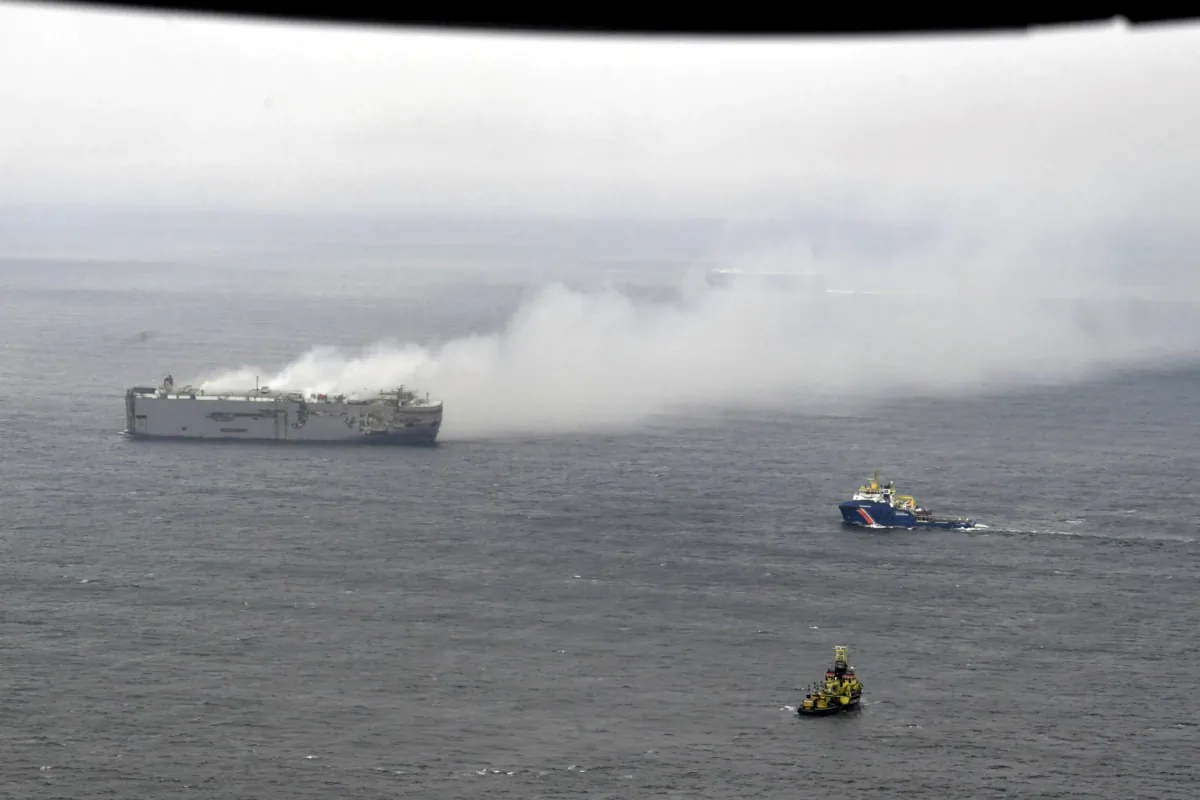
Smoke is seen from a freight ship in the North Sea, about 27 kilometers
(17 miles) north of the Dutch island of Ameland on July 27, 2023.
(Kustwacht Nederland/Coast Guard Netherlands via AP)
An electric car has been suspected of causing a blaze aboard a cargo ship carrying almost 3,000 vehicles off of the Netherlands.
The ship’s owners told Dutch media that they suspect an EV battery explosion for being the cause of the deadly fire.
The Dutch Coast Guard said that the 18,500-tonne burning car carrier, Fremantle Highway, was en route from Bremerhaven, Germany, to Port Said, Egypt, when the blaze broke out on Wednesday.
It said, citing a freight list, that the ship was carrying 2,857 vehicles, including 25 electric cars.
Pat Adamson, company spokesman for K Line who chartered the ship, later corrected that number to a total of 3,783 new vehicles, including 498 electric vehicles. He added that K Line didn’t know the source of the incorrect freight list.
Shoei Kisen Kaisha, the Japanese ship leasing company that manages the Fremantle, said that the cargo ship was underway to its final destination in Singapore when the fire broke out.
Around 350 of the vehicles on board were cars from Mercedes-Benz, said the shipping company.
“There is a good chance that the fire started with electric cars,” the company told the NOS public broadcaster. “But we are not entirely sure of the cause, we are waiting for the investigation.”
Bloomberg ship tracking data reported that the ship left the German port of Bremen on July 25 before deviating off course after the fire broke out.
Crew Rescued From Burning Car Carrier
Rescue ships and helicopters evacuated 23 crew members, mostly from India, but one sailor was killed in the blaze, reported Dutch broadcaster NOS.
Several crew members jumped overboard to escape the quick-moving flames and were treated for injuries, said Willard Molenaar of the Royal Dutch Rescue Company (KNRM), who was among the first at the scene.
“There was a lot of smoke, and the fire spread quickly, much faster than expected,” he said, adding that “the people on board had to get off quickly … We fished them out of the water.”
“They all suffered from breathing problems, but none are in serious danger,” another safety official told AFP.
Dutch Authorities Attempt to Salvage Vessel
On Friday, flames and smoke had subsided enough for salvage experts to board the ship for the first time and establish a strong towing connection with a tugboat, the Dutch Ministry of Infrastructure and Water Management said.
It will be towed, likely over the weekend, to a new position 16 kilometers (10 miles) north of the island of Schiermonnikoog, the ministry said in a statement. The timing of the operation is expected to take 12–14 hours, depending on smoke development and weather, the ministry added. The aim is ultimately “once conditions on board allow,” to tow the ship to a yet-undecided port.
The ministry said the ship is stable and intact below the waterline.
The burning vessel is close to the shallow Wadden Sea, a World Heritage-listed area that is considered one of the world’s most significant habitats for migratory birds. It’s also near the Netherlands’ border with Germany, whose environment minister, Steffi Lemke, has warned of “an environmental catastrophe of unknown proportions,” if the ship were to sink.
Lithium Ion Batteries Blamed for Series of Accidental Fires
Shipping company Wallenius Wilhelmsen warned earlier this year about such fires occurring at sea.
“Shipping companies are facing an added concern with the increasing demand for electric vehicles,” said Wallenius.
“Fires onboard vessels can have catastrophic consequences, and battery fires are extra potent and dangerous.”
“Li-ion batteries generate extreme heat when they malfunction, often reaching temperatures of 800 degrees Celsius or higher. This heat can quickly spread to nearby combustible materials, causing a rapid fire that’s challenging to extinguish,” they wrote.
The International Maritime Organisation, which sets out regulations for safety at sea, now plans to evaluate new safety measures for ships transporting electric vehicles in 2024 after a series of fires on cargo ships, a spokesperson said.
Fires on car-carrying ships are increasingly becoming the source of major losses, insurers warn.
“Electric cars burn just as much as combustion engine cars. When batteries overheat and a so-called ‘thermal runaway’ occurs, then it gets dangerous,” wrote Uwe-Peter Schieder, master mariner and representative of the German Insurance Association. “A chemical reaction in the battery produces gases which inflate the battery.”
The new rules could take years to implement but may include specifications on what types of water extinguishers can be used on boats and limitations on the amount a battery can be charged to prevent fires.
The Fremantle incident was the latest in recent times regarding fires and accidents involving car carriers.
In 2019, about 340 containers tumbled off one of the world’s largest container ships after a storm in the same area off the Netherlands, littering miles of protected coastline with plastic and polystyrene.
Last year, a fire sparked by an electric vehicle sunk the Felicity Ace off the coast of the Azores in the Atlantic Ocean with some 4,000 vehicles from German car maker Volkswagen on board.
Earlier this month, two New Jersey firefighters were killed and five injured, while battling a blaze on a cargo ship carrying hundreds of vehicles, but no electric cars were on board that vessel, the operator said.
The Associated Press and Reuters contributed to this report.
UPDATE: This article has been updated to include comment from K Line spokesman Pat Adamson.
No comments:
Post a Comment